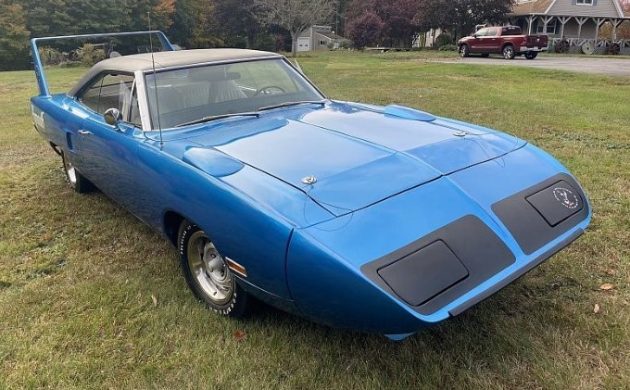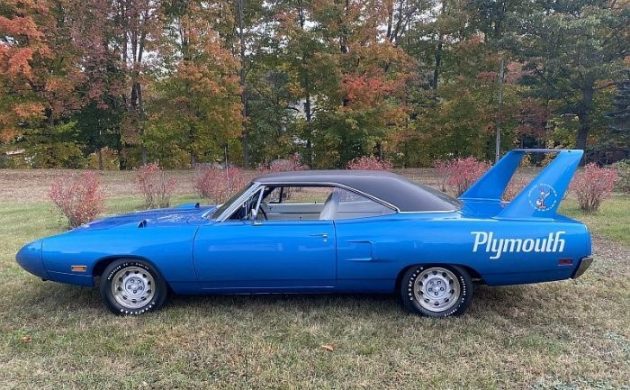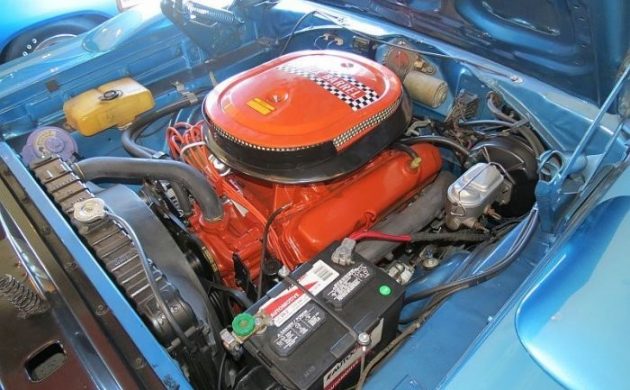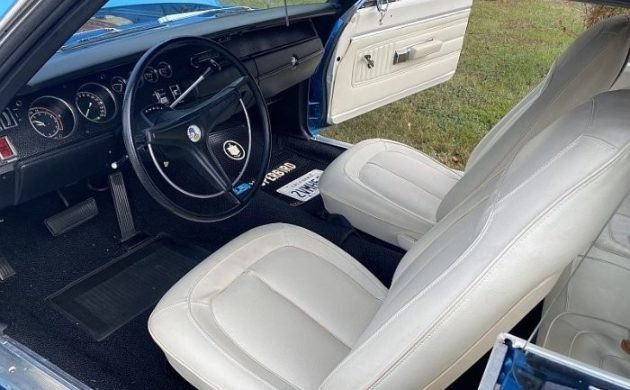We will almost certainly never again see vehicles like this 1970 Plymouth Superbird. They hailed from a period when NASCAR competition was literally for “stock cars,” and competitors were required to drive what were effectively race-tuned versions of roadgoing vehicles. Today, most saloon car categories, including NASCAR, use bodies that vaguely resemble production versions draped over a common platform. That makes these cars hugely significant from a motorsport perspective but equally as important as classic road cars. This 1970 Superbird is amongst the most incredible examples that you are likely to find today. It has belonged to the same owner since the day that it rolled off the showroom floor. It presents superbly, and it is as structurally solid as it is spotlessly clean. After 51-years with its original owner, the time has come for it to go to its next home. Located in Templeton, Massachusetts, you will find the Superbird listed for sale here on eBay. The bidding has been as spirited as you might expect, with 16 people putting up their hand for this classic. This action has pushed the price along to $138,100, but the reserve hasn’t been met.
The reality is that road cars are designed to do many things, but one thing that they were never designed for was to be plonked on a race track. That is why open-wheel and prototype sports racers look the way that they do. Their designers want to exploit the maximum amount of aerodynamic efficiency while creating as much downforce as their regulations will allow. By comparison, most average road cars have the aerodynamic properties of a barn. This is purely for practical reasons. Manufacturers could design vehicles that are lower, smoother, and with a more pronounced rake on the windshield, but these would be severely compromised for daily use. Take the enormous rear spoiler off this Plymouth, and the problem becomes apparent when you look at the vehicle in profile. The vehicle’s underside is relatively flat, while the upper surfaces curve to a peak at the highest point on the roof and taper to the taillight panel. That is, to all intents and purposes, an aerofoil. It is the sort that you find on any fixed-wing aircraft. It effectively means that the faster a road car goes, the more lift it generates. If you could drive a road car fast enough, its wheels would eventually lose contact with the ground. That is why companies like Plymouth created the Superbird for NASCAR competition. The sleek and pointed nose cut through the air more smoothly than the original, blunt production design. The tiny spoiler under the nose and that enormous rear wing were there to eliminate that lift and provide positive downforce, allowing for increased cornering speed on high-speed tracks like Daytona and Talladega.
The Superbird presents superbly, and it stands as a testament to the care and respect that has been lavished on it by its single owner. The owner treated it to a repaint in its original Code B5 Blue Fire in 1996, and it still shines beautifully today. The panels are laser straight, with no dings or dents. There is no evidence of rust and the photos of the underside show floors and a frame that are clean enough to eat off. The car was built with a Black vinyl top, and this looks as good today as it would’ve looked back in 1970. All of the distinctive aero additions that are the hallmark of a Superbird are present, and they show me evidence of any cracks or flaws. The decals are crisp and clean, while the original Rallye wheels and the glass are flawless.
Lifting the hood reveals an engine bay that contains the mighty 440ci V8 that has become the stuff of legends. This monster is backed by a 3-speed TorqueFlite transmission, while the car also features power steering and power front disc brakes. This is a numbers-matching classic, but it does have a story behind it. When the original owner was searching for a Superbird, he was looking for a specific combination of color, trim, and drivetrain. This one came close, but it featured the 440/4-Barrel V8. He wanted a Six-Pack, so he had the dealer perform a swap of induction systems prior to delivery. That means that the carburetors, intake, and air cleaner aren’t original to this car. However, that is not an issue because the dealer wrapped the original components in a blanket and placed them in the trunk of the Plymouth. The owner removed the items when he took the car home and stored them carefully. Photos of these components are seen in the listing, and not only are they are in as-new condition but they are included in the sale. In its original form, this V8 would have been pumping out 375hp, which was enough to propel the Superbird through the ¼ mile in 14.3 seconds. Adding the Six-Pack boosted the power figure to 390hp and dropped the ET to 14.2 seconds. It seems that there is nothing but good news with this classic. During its 51-years, it has only accumulated 54,000 miles on its odometer. The owner doesn’t mention whether he specifically holds evidence to verify this, but judging by the scope of documentation that is contained in an enormous binder folder, I would say that there’s a good chance that he does. The folder contains all of the dealer paperwork, the original title, every registration dating back to 1970, plus numerous other items that provide an insight into this car’s life. This Superbird isn’t a classic that is merely about good looks because it runs and drives like a new car. The owner provides several videos in his listing, and the engine sounds crisp and clean, while the Plymouth drives without any evidence of squeaks, rattles, or other unwanted noises.
The owner knew what he wanted when he went searching for this Plymouth. His wish list included B5 Blue paint, a 440 Six-Pack, and a white interior. He managed to achieve these aims, and the car remains in those specifications today. While the exterior was repainted in 1996, the interior has never been touched. All of the upholstery is original, and its condition is astounding when you consider the color choice. White trim can become dirty, stained, and it is also prone to developing a yellow tinge over time. None of those problems have affected this car, with it looking like it has just rolled off the showroom floor. The dash and pad are flawless, there is no wear on the carpet, and there have been no aftermarket additions. The Rally gauge cluster looks crisp and clean and includes the ultra-cool Tic-Toc-Tach.
They don’t make them like they used to, and sadly, that is the case with cars like this 1970 Plymouth Superbird. This is an extraordinary car from an era when vehicle manufacturers maintained a hands-on involvement in motorsport at a grass-roots level. Without that involvement, these cars would never have existed. This one is remarkably well preserved, and I hope that its new owner continues to treat it with care and respect. The harsh reality is that we are now heading towards a future where hybrid and zero-emission vehicles will almost inevitably dominate our marketplace. Eventually, cars with V8 internal combustion engines will go the way of the dinosaurs, and that is a sobering thought. However, vehicles like this will allow the memories to remain vivid in our minds and enable future generations to gain an insight into what has been lost to the automotive world. The Plymouth Superbird served an important role in our motoring past, and its role in the future could be equally as important. That’s why preserving these classics is so important. They need to be seen in person and not consigned to the faded pages of some history book.








” However, vehicles like this will allow the memories to remain vivid in our minds and enable future generations to gain an insight into what has been lost to the automotive world. The Plymouth Superbird served an important role in our motoring past, and its role in the future could be equally as important. That’s why preserving these classics is so important. They need to be seen in person and not consigned to the faded pages of some history book.” Well spoken, Adam! These are my sentiments as well, and there is nothing I can add to this! A really beautiful example, GLWTA!! :-)
just wow.!!!!!!
A lowrider with wing.
Happy Cinco de Mayo!
Gracias Senor Don !
Why doesn’t the chrome trim around the bottom of the vinyl roof meet the chrome surround around the rear window? Those small black pieces look hinky to me.
Superbirds had a special aerodynamics enhancing rear window installed in them that was considerably smaller than the original Road Runner / Belvedere / Satellite / GTX rear window. There was a formed steel plug that was welded and heavily puttied in place of the original window to allow proper fitment of the special window. This made the original vinyl roof trim fit incorrectly. Rather than retool to make a few thousand special length trim pieces, Chrysler hammered out the funky little black pieces to fill the void.
I thought they only did that with Daytona’s and 69 Charger 500’s, not Superbirds.
Steve R
You thought wrong. They also used ’70 Dodge Coronet fenders.
Steve R, the Charger 500 and Daytona also used the “plug”, but as there were only about five hundred of each built for homologation, they were sold with a slick roof, and the plug was properly bodyworked into the roof on the assembly line to make it look right.
When the rules changed for 1970 and Plymouth was required to build over two thousand Superbirds, the decision was made to use a vinyl roof to hide a half-assed attempt at integration instead of investing the time and effort to make the plug look “right”. And with only a couple thousand copies or so produced, the standards for things like top moldings were pretty low, too.
Superbirds seem to have two personalities. The racecar outside that just screams power and the interior, which looks perfect for a drive to church…especially those with column-shifted automatics and bench seats. Still a car I’d love to own if I was insanely rich.
I remember these – that was back when I used to watch NASCAR…
Thanks for the eye candy! Wow!
The Superbirds were cooler to me than the Daytonas were. The shape just looked better to me. And King Richard sure knew how to wheel one around the NASCAR circuit too back then. The Ford and GM boys really had nothing but a bit of luck when it came to beating one of the winged MOPARS then. Wish NASCAR would have let the wing cars stay around, can you imagine what the other manufacturers would have come up with to try and compete?
This is such a clean car, I would sell my house to get this car. But I don’t want to move from the living room couch to the garage just for pissing off the boss.
Bought in Tenn, titled in Ind., now in Mass. with a Calif. tag ???
Beautiful car!!
Richard Amistadi is a Mass. dealer. He bought a pair of Superbirds.
I appreciate the dealer installed 6 pack, but no mention of it in any of the supplied documentation? Not to knock the car-super clean an what a paper history.
The factory six pack engines had different rods and some other internal improvements over the base 440 4bbl didn’t they? Nice car!
In 69, six pack motors used standard rods and crank damper. In 70 they were equipped with wider, heavier rods and an offset balancer to compensate for the weight. In 71 and later, all 440 magnums had the big rods and offset balancer. We used to get them out of cop car motors, where most people didn’t think to look.
Richard Amistadi is a Mass. dealer. He bought a pair of Superbirds.
Ya had to be special kind of nut to buy one of these for street duty.
I’ve seen this Superbird up close, the only other time it was auctioned. It was at the Owl’s Head Auto Auction in August ’18. We went to the museum the day after the auction and most of the auctioned cars were still sitting there, and you could walk right up to them and have a really close look.
This car (yes, another column shifter!) is as nice as it looks in the pictures – flawless! I remember the story of the original intake, carb, and air cleaner being saved.
It sold for $170,000 then.
http://www.dodgecharger.com/forum/index.php?topic=132820.0
Not sure why NASCAR continues with the same name abbreviation, as they certainly do not use stock cars at all. They should have changed it, and if anyone wants to start up an association that races stock cars, they should be able to use the moniker.
Anyhow, beautiful car. I remember an older student had a yellow me at my high school. Ahh the memories.
Luv the many photos and videos. I hope it sells.
Beautiful car, and no intent here to diminish that. But, I’m puzzled. How many ‘owners’ or caretakers has this car had? Bought from a museum? Caretaker for years, and “I’ve never registered it”? As said, beautiful.
cant tell you how much it hurts me to see cars like this and have an automatic on the column, what a waste of a car
Badly wanted a Superbird then; ended
up with a 6bbl GTX… Not sorry!
Also appears to have the
wrong exhaust hangers
behind mufflers. Picky…
but find the correct ones.
It’s okay to be picky with a car like this. A friend of mine bought one exactly like this one new, and still has it. He’s so picky that when he suffered a tire puncture many years ago, rather than plug it or buy one new Goodyear Polyglas GT, he bought four so they would have evenly matched tread wear, despite the fact that the ones he replaced probably had fewer than 500 miles on them.
Now that is stock car racing!
I can’t understand the “sky high” prices for the “poor quality” made Chrysler products! The only good thing about them were their drivetrains!
The fact that they were poorly made means few survived.
It was hemi orange with black Vinal 4 speed , 426 12 pack hemi , lost forever